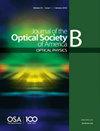EIT发动机中的激光波动效应
IF 1.9
4区 物理与天体物理
Q3 OPTICS
Journal of The Optical Society of America B-optical Physics
Pub Date : 2023-11-13
DOI:10.1364/josab.504093
引用次数: 0
摘要
在与冷热储层接触时,在强耦合场的驱动下,三能级原子通过模拟热机运行过程的一系列跃迁产生光子。输出光子的亮度可以比热储的亮度大得多,其效率可以比卡诺热机的效率大得多[物理学]。[j].中国生物医学工程学报,2016,32(5):557 - 557。该机制的核心要素是由耦合场引起的一种称为电磁感应透明的干涉效应,它通常是一种没有任何随机相位变化的完美激光。在本文中,我们研究了一个更现实的模型,其中考虑了耦合场的时间波动。在分析中运用热力学定律,我们发现除了降低发动机的功率外,一个较强的波动从根本上改变了系统的性能,甚至使其失去了作为热机的品质。我们找到了最大允许波动的相应准则。当发动机工作在激光阈值以下时,熵的变化表明,波动的影响相当于提高冷库的温度。本文章由计算机程序翻译,如有差异,请以英文原文为准。
Laser fluctuation effects in EIT engine
In contact with a hot and a cold reservoir, the three-level atom driven by a strong coupling field generates photons via a sequence of transitions that mimics the running process of a heat engine. The brightness of the output photon can be much larger than that of the hot reservoir, and its efficiency could be larger than that of the Carnot engine [ Phys. Rev. A 94 , 053859 ( 2016 ) PLRAAN 1050-2947 10.1103/PhysRevA.94.053859 ]. The core element of the mechanism is an interference effect called electromagnetically induced transparency caused by the coupling field, which is commonly a perfect laser without any random change in the phase. In this paper, we investigate a more realistic model where the temporal fluctuation of the coupling field is considered. By applying the laws of thermodynamics in the analysis, we find that in addition to the reduced power of the engine, a relatively strong fluctuation changes the properties of the system radically, even making it lose the quality of being a heat engine. We have found the corresponding criteria for the maximal allowed fluctuation. The entropy changes when the engine works below the laser threshold suggest that the effect of the fluctuation is equivalent to increasing the temperature of the cold reservoir.
求助全文
通过发布文献求助,成功后即可免费获取论文全文。
去求助
来源期刊
CiteScore
4.00
自引率
5.30%
发文量
374
审稿时长
2.1 months
期刊介绍:
The Journal of the Optical Society of America B (JOSA B) is a general optics research journal that complements JOSA A. It emphasizes scientific research on the fundamentals of the interaction of light with matter such as quantum optics, nonlinear optics, and laser physics. Topics include:
Advanced Instrumentation and Measurements
Fiber Optics and Fiber Lasers
Lasers and Other Light Sources from THz to XUV
Light-Induced Phenomena
Nonlinear and High Field Optics
Optical Materials
Optics Modes and Structured Light
Optomechanics
Metamaterials
Nanomaterials
Photonics and Semiconductor Optics
Physical Optics
Plasmonics
Quantum Optics and Entanglement
Quantum Key Distribution
Spectroscopy and Atomic or Molecular Optics
Superresolution and Advanced Imaging
Surface Optics
Ultrafast Optical Phenomena
Wave Guiding and Optical Confinement
JOSA B considers original research articles, feature issue contributions, invited reviews and tutorials, and comments on published articles.

 求助内容:
求助内容: 应助结果提醒方式:
应助结果提醒方式:


